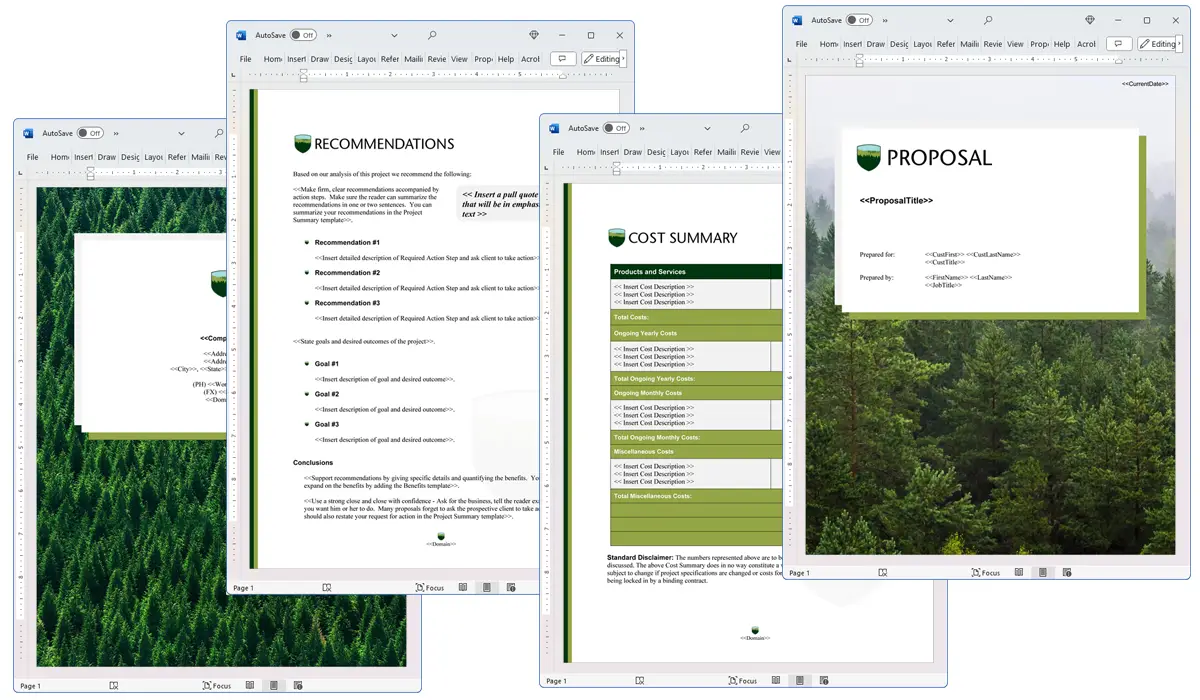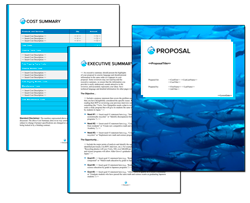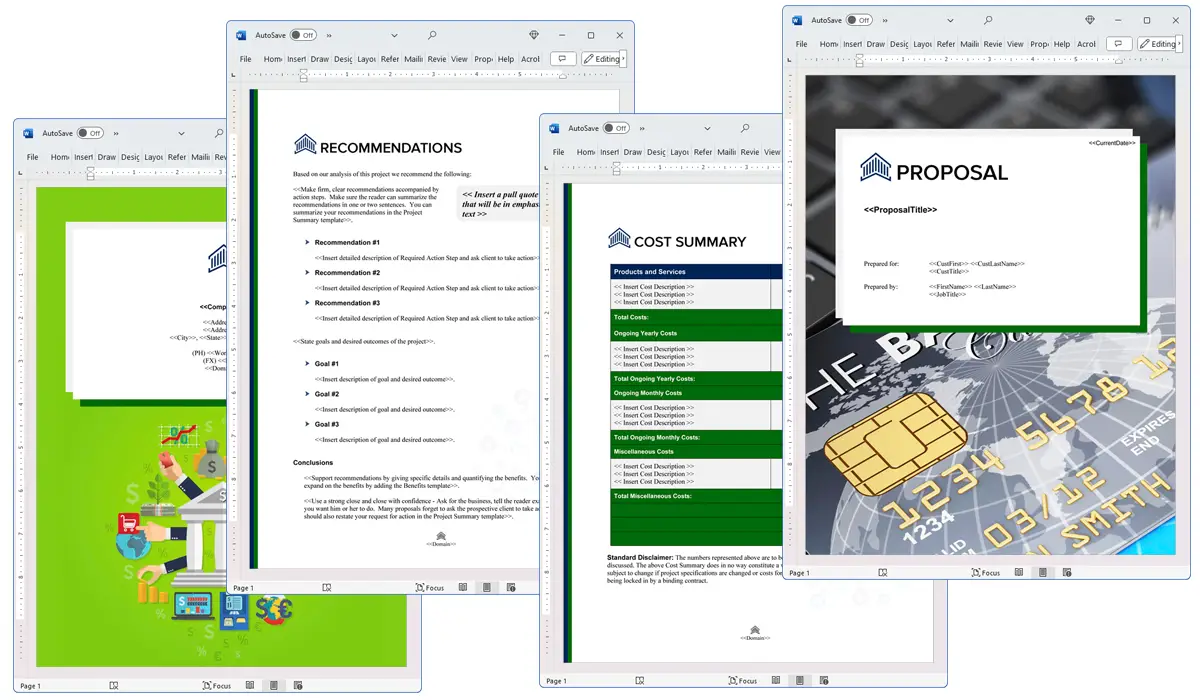What is the Judging chapter used for?
Proposal Kit Professional Bundle adds more design themes, all six Contract Packs,
a project management library, and Expert Edition software.

Illustration of Proposal Pack Nature #9
We include this Judging chapter template in every Proposal Pack, along with thousands more. You assemble this chapter with others in various combinations to create custom-tailored business proposals, plans, reports, and other documents. Proposal Packs apply custom visual designs to the templates, giving the final documents a consistent professional finish.
 DOWNLOADABLE, ONE-TIME COST, NO SUBSCRIPTION FEES
DOWNLOADABLE, ONE-TIME COST, NO SUBSCRIPTION FEES
Overview of the Judging Chapter
The Judging chapter is a vital piece of the Proposal Kit system, often included in various business proposals. This chapter is specifically designed to clarify and detail the process by which proposals, applications, or entries will be evaluated. It sets clear expectations for both the entity requesting the proposal and those who are submitting their entries. The Judging chapter ensures transparency and fairness in the evaluation process, which can enhance the credibility and professionalism of the proposal.
How is the Judging Chapter Used?
When used in a business proposal, the Judging chapter is used to describe how submissions will be evaluated. Whether the proposal is part of a request for proposals (RFP), a contest, or any competitive process, this chapter outlines the criteria and process used to judge entries. It helps to prevent misunderstandings and disputes by providing a clear, agreed-upon framework for evaluation, which can be particularly important in competitive business environments.
What is Included in the Judging Chapter?
The Judging chapter typically includes several key elements:
- Criteria: Detailed explanation of the criteria used to judge submissions. This could include quality of work, cost-effectiveness, innovation, and adherence to guidelines.
- Process: Description of the process by which judging will be conducted. This might outline the stages of evaluation and who will be involved in the decision-making process.
- Timeline: Information on when the judging will take place and when results can be expected.
- Scoring System: If applicable, a breakdown of the scoring system used to evaluate submissions, which provides transparency.
- Appeal Process: Sometimes, details on an appeal process are included, offering submitters a way to contest the decision if they believe there was an error in the judging process.
Use Case Examples for the Judging Chapter
- Finance: Judging the best investment proposals based on risk analysis and expected returns.
- Insurance: Evaluating different policy proposals based on coverage details and premium costs.
- Legal: Selecting the right legal services based on expertise, past success rates, and cost.
- Request for Proposal: Outlining how technology vendors will be assessed in a government RFP for new software systems.
- Contests: Describing how entries in an advertising campaign contest will be judged based on creativity, impact, and audience engagement.
Key Takeaways
- The Judging chapter is important for defining how proposals, applications, or contest entries are evaluated.
- It enhances transparency and fairness, which are crucial in competitive business dealings.
- This chapter typically includes criteria, judging process, timeline, scoring system, and potentially an appeal process.
- It is applicable across various industries including finance, insurance, legal, and more.
- The Judging chapter is a core part of ensuring that all parties understand the basis on which decisions will be made, making it a foundational part of many business proposals.

Illustration of Proposal Pack Ranching #3
 What Our Clients Say
What Our Clients SayAs a small business consultant, I am often called upon to assist in preparing contractual documents in many different areas. The Proposal Kit is an excellent time saver and has references to many key points that should be addressed for clarity and assigning responsibility. The ability to easily add unique logos, covers, and page formatting allows each contract to be distinctly different. Definitely add this to your toolbox."
CEO at W.O. Green Corporate Services
 4.7 stars, based on 845 reviews
4.7 stars, based on 845 reviewsRelated Chapters

The Judging chapter and other chapters are integrated into a Word document as illustrated here in the Proposal Pack Financial #5 design theme. There are hundreds of design themes available, and every design theme includes the Judging chapter template.
A proper business proposal will include multiple chapters. This chapter is just one of many you can build into your proposal. We include the complete fill-in-the-blank template in our Proposal Pack template collections. We also include a library of sample proposals illustrating how companies in different industries, both large and small, have written proposals using our Proposal Packs. This template will show you how to write the Judging.
We include a chapter library for you to build from based on your needs. All proposals are different and have different needs and goals. Pick the chapters from our collection and organize them as needed for your proposal.
Using the Proposal Pack template library, you can create any business proposal, report, study, plan, or document.
 Ian Lauder has been helping businesses write their proposals and contracts for two decades. Ian is the owner and founder of Proposal Kit, one of the original sources of business proposal and contract software products started in 1997.
Ian Lauder has been helping businesses write their proposals and contracts for two decades. Ian is the owner and founder of Proposal Kit, one of the original sources of business proposal and contract software products started in 1997.By Ian Lauder
 Published by Proposal Kit, Inc.
Published by Proposal Kit, Inc.


 Cart
Cart
 Facebook
Facebook YouTube
YouTube X
X Search Site
Search Site